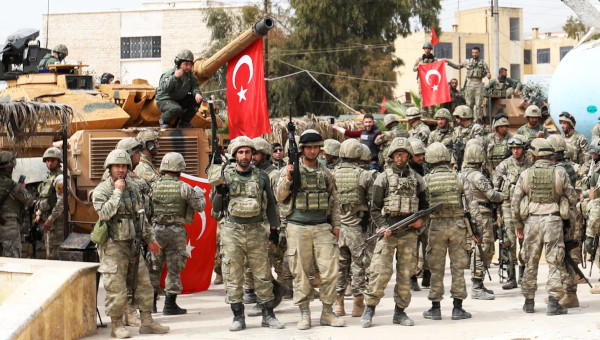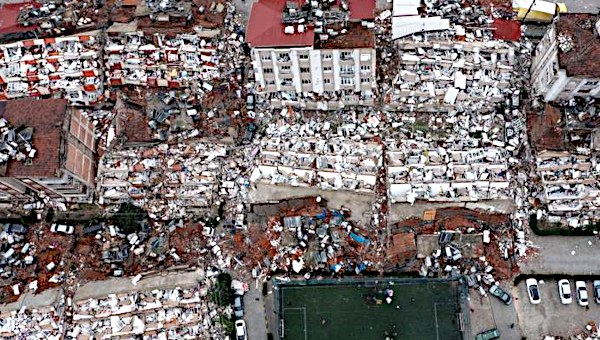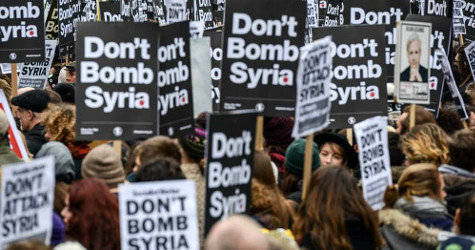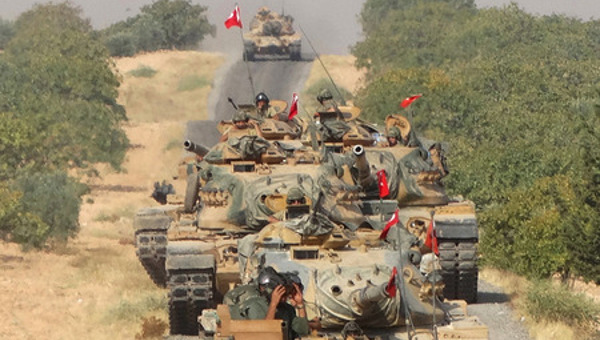The struggle between the Baath regime of Bashar al-Assad and the popular masses of the city and country in Syria that started on 15 March 2011 seems to have consumed both sides in its ferocity. It is promising imminent victory to a third force that has been carefully engineered, supported and armed by the international forces of counterrevolution. This third force is a bourgeois coalition composed of different political tendencies, including opportunist pro-imperialist bourgeois politicians living in exile and waiting for their day to come, Sunni Muslim movements of various stripes, most saliently the Muslim Brotherhood, direct representatives of various sections of the Syrian bourgeoisie and defectors from the Syrian army. The forces of international counterrevolution, consisting mainly of imperialism, first and foremost the U.S. of course, Sunni Arab reaction led by Saudi Arabia and Qatar, and Turkey (Israel has kept an incredibly low profile) seem to be nearing success in their grand aim of deviating the uprising of the popular masses, an authentic part of the Arab revolution, into a ‘responsible,’ pro-imperalistic movement that can take Assad’s place without a radical rupture with the existing bourgeois state.

However, as the Syrian revolution prepares to leave the stage in favour of a new bourgeois government, it has very recently begotten a side product that is capable of shaking the status quo not only of Syria, but of the whole region in the form of an autonomous region taking shape in the Northern provinces of Syria. A new autonomous Kurdistan is emerging under our very eyes and this time, unlike the Regional Government of Kurdistan in the North of Iraq, it has not been engineered by the United States.
How Imperialism, Arab Reaction and Turkey Have Supplanted the Syrian Revolution
Despite persistent groundless rumours to the contrary, the Arab revolution that started in Tunisia in late 2010 and spread like wildfire to many other Arab countries (Egypt, Bahrein, and Yemen to cite only the most prominent instances) caught imperialism unawares and caused its position in the Arab world serious damage. Apart from the dynamic of permanent revolution that was set in motion especially in Egypt, where proletarian struggle was decisive even in this early phase of the revolution, and the alternative prospect of the rise to power of this or that stripe of political Islam, the best organized opposition in these countries for decades, there was also a threat to Israel and the three-decade status quo of the Middle East built on Camp David. Faced with the formidable onslaught of the masses most graphically symbolised by Tahrir, imperialism, after some improvisation, devised a strategy. This was coined ‘orderly transition’ and was based on saving what can be saved of the institutions while sacrificing the most salient actors of the ancien regime. The dumping of Ben Ali (Tunisia), Hosni Mubarak (Egypt), and Ali Abdullah Saleh (Yemen) was essential to bring down the fever of the masses. Additionally, an imperialist coalition led by the U.S. and France jumped on the regional and tribal civil war in Libya to support the opposition to Muammar Gaddafi militarily so as to create a safe base for imperialist intervention in both Egypt and Tunisia should these two revolutions, the most advanced so far, get out of hand.
Syria has its specificities. It is, most importantly, an immediate neighbour to Israel. Although the Zionist entity considers the Baath regime to be a traditional enemy, one should not forget that, through the intermediation of Recep Erdogan, the Turkish prime minister, Israel and Syria were on the verge of creating their own version of Camp David until the Zionist attack on Gaza in late 2008 destroyed the whole enterprise. Fearing that a Sunni Islamist alternative to the Alawi and, one could even say secular, government of Assad would be even more of a threat to Israel, the U.S. and the Zionist establishment, when confronted with the Syrian revolution in March 2011, at first opted for reform of the existing regime in order to absorb the demands of the mass movement. This was also the line pursued by the moderate Islamist government of Erdogan in Turkey, since it had invested so much in its relations with the government of Assad in previous years.
But the Assad government and the Sunni, Christian and Alawi big bourgeoisie closely intertwined with the Baath officialdom in its socio-economic existence were not ready to yield any serious ground to the demands of the masses. Only when it realised this inability or reluctance did the international counterrevolutionary coalition turn its back on Assad. Approximately six months after the revolution started, in late summer 2011, the Turkish government created to customised order an opposition under the umbrella of the so-called Syrian National Council (henceforth SNC) in the image of the National Transitional Council in Libya, in order to form a ‘respectable’ bourgeois opposition in exile bringing together all tendencies loyal to the imperialist order. This was some months later supplemented by the creation of the Free Syrian Army (FSA), which is blatantly given sanctuary and training by Turkey, armed with Saudi and Qatari money, and provided intelligence by the USA. The bourgeois opposition represented by the couple SNC-FSA is a creature of imperialism, Arab reaction and Turkey to divert the Syrian revolution into a route acceptable to them.
‘Friends of Syria’
The strategy here is again one of ‘orderly transition.’ Of the three conferences organized by the so-called ‘Friends of Syria,’ bringing together imperialist countries, members of the Arab League, Turkey and other hangers-on of imperialism, the most important one was that in Istanbul, held at the beginning of April this year. The resolution adopted here stood out for its clarity of purpose: ‘a peaceful, orderly and stable transition’ (‘peaceful’ is, of course, sheer hypocrisy) and an insistence on the preservation and reform of the institutions of Syria. This second point is again geared to the strategy of saving as much as possible the existing regimes so as to rule out popular rule or an Islamic regime.
However, as opposed to the experience of the National Transitional Council in Libya, the SNC has not, in its year-long existence, been able to hegemonize the Syrian opposition. There are several factors at play here. First, many forces of the popular revolution proper, starting with left-wing movements, have adamantly come up against foreign intervention and exposed the SNC as a puppet of imperialism and Arab reaction. Secondly, movements representing the Kurds, an oppressed nationality predominantly living in the north of the country, did not and do not see even a glimmer of hope in the political orientation of the opposition. Thirdly, the SNC cannot even create a harmonious relationship between the different bourgeois tendencies. There is a growing fear within the international counterrevolutionary camp that the SNC and the armed struggle inside the country are being increasingly dominated by the Muslim Brotherhood, a moderate pan-Arab movement that is the rising force in Egypt as well, as well as Salafist movements, closer to Saudi Arabia, and even Al Qaeda.
This last tendency of growing Islamic influence in the opposition movement is closely linked with an explosive aspect of the struggle over Syria. The latter country has now become the frontline theatre of the struggle between the Sunni Islamic camp being built by Saudi Arabia as against the Shiite-Alawi front spearheaded by Iran. Syria is but one of the chain of forces that now stand in alliance with Iran: the newly Shia-dominated Iraq and the Hezbollah, which is the strongest power behind the current government in Lebanon, in addition to Alawi-dominated Syria (the Alawis are close to the Shia in certain ways but very different in others, the real uniting force being their common opposition to the dominant Sunni denomination.) Hamas in Palestine, once an important ally of Iran, has given indications of going back to the Sunni fold under the impact of the rise of the Muslim Brotherhood in the wake of the Egyptian revolution. So the struggle over Syria is also part of a broader sectarian rivalry between the Sunni and the Shia that threatens a full-scale conflagration in the Middle East, which, if unleashed, would threaten to reach barbaric dimensions.
“It is the money of Saudi Arabia and Qatar, the sanctuary and training offered to the bourgeois opposition by Turkey and the overwhelming diplomatic influence of imperialism that have together given the upper hand to the bourgeois opposition over the popular movement.”
Despite all of these contradictions within the pro-imperialist bourgeois opposition camp, the fighting inside Syria, which started out as hit-and-run operations in restricted localities, has become a full-scale civil war, with the opposition now reportedly in control of many areas. There have been a series of defections from the army and the civilian bureaucracy (most spectacularly some ambassadors). Most important is the recent defection of Manaf Tlas, a general of the Republican Guard, the praetorian army of the Assad family. The Sunni Tlas family is only second to the Assad family in the Baath regime and one of the most powerful capitalist families of the country. Manaf is possibly being regarded as a candidate to lead a transitional government. This would guarantee the survival of capitalist power in the country. Tlas has the additional advantage of possible support from Russia, the most active opponent of the imperialist coalition in the Syrian affair, together with China and Iran.
It seems the days of Assad are numbered. Were Tlas or someone similar to lead the transitional government, the strategic aim of imperialism would be fulfilled, with the institutions of the state or partially even those of the regime being preserved and a capitalist Syria subservient to imperialism guaranteed. This most likely scenario would signify the gentle death of the popular revolution in Syria. It is the money of Saudi Arabia and Qatar, the sanctuary and training offered to the bourgeois opposition by Turkey and the overwhelming diplomatic influence of imperialism that have together given the upper hand to the bourgeois opposition over the popular movement. The political responsibility of the Syrian left is yet to be studied once the enigma that is the Syrian revolution at this point reveals its secrets in the future. Yet we still cannot declare the consummation of the death of the Syrian revolution. Many a surprise may lie in store in the post-Assad period for the world.
The Dying Syrian Revolution Begets a Baby:
Autonomous Western Kurdistan
The recent events unfolding in the north of Syria bring in new elements into the equation. Since 20th July, the cities of northern Syria, including the largest city Qamishlo, have been taken over one after another from the representatives of the Baath government by the Kurdish people. The people of these cities and towns have formed councils to run local affairs and militia to defend the new political setup. Kurdish flags are everywhere.
To understand what is happening, one needs to have background information on the situation of the Kurds in the Middle East. The history of the Kurds, one of the autochtonous peoples of the region, and of Kurdistan is a long and complicated one. Suffice it to say that since World War I Kurdistan has been divided into four parts, each colonized by a Middle Eastern state, namely Turkey, Iran, Iraq and Syria. So what is northern Syria in terms of the status quo of international law is, in fact, Western Kurdistan. For long decades the four parts of Kurdistan were enslaved, with differing degrees of national oppression at different times and places, by these four states. Hence, the fight of the Kurdish people for the right to self-determination and national unification is a most rightful cause. There were, of course, revolts and wars of national liberation throughout the twentieth century, bringing fleeting victory at times. But only at this beginning of the twenty-first century is slowly emerging the silhouette of a Kurdistan.
Two factors of quite different origin are at play here. One is the creation of an autonomous Kurdistan in northern Iraq with U.S. sponsorship within the process of imperialist assault on Iraq since the First Gulf War of 1991. The leader of this Kurdistan Regional Government, an entity inside federal Iraq, is Barzani. The other is the fight waged by the PKK (Kurdistan Workers’ Party) ever since a guerrilla war within Turkey was started in 1984. Although the leader of the PKK, Abdullah Ocalan, was captured by the CIA and turned over to Turkey in 1999, and although Ocalan has been kept in solitary confinement in an island prison for the last twelve years, the PKK now has a mass following, which is also the electoral base for a legal party that is represented by a whole parliamentary group. The party is also a very serious political force among the Kurds of Iran and Syria through local parties that are loosely affiliated to it.
It is important to understand that due to these circumstances, Barzani and the PKK are contending forces competing with each other for hegemony over the totality of Kurdistan. In this competition the U.S. and Turkey are allies of Barzani. Turkey has in recent years carried out secret abortive negotiations with Ocalan in prison and the PKK leadership separately, but the Turkish state and the PKK are still hostile forces. As for the U.S., the PKK has never been an attractive ally since it is a foe of the cherished American ally and NATO member Turkey and a rival of the Barzani leadership.
Against the background of this information, the current situation in Western Kurdistan (nothern Syria) presents some very interesting features. First of all, it should be noted that the forces that took over Kurdish cities from the government institutions are a coalition of partisans of the PKK and sympathisers of Barzani. Given what was said above regarding the four-cornered relationship between the U.S., Turkey, Barzani and the PKK, this is a most unexpected situation. This can be explained by the fact that, disturbed by clear PKK hegemony over Western Kurdistan, Barzani tried, right before the conquest of Kurdish cities, to bring all Syrian Kurdish political forces together in a front, so as to be able to keep the PKK under control. The fact of the matter is that the partisans of the PKK are visibly hegemonic despite this kind of attempt at control.
Second, after decades of Kurdish enslavement, this is the second Kurdish entity to emerge in the space of a mere decade. This, of course, raises eyebrows in all four oppressor countries, even Iraq, where there is a growing fear of a prospective declaration of independence on the part of Barzani. Most recently, the federal army of Iraq has started to threaten the peshmerga of Barzani with an attack.
Third, this entity promises, if it is able to survive, to be a very different one from that in Iraq. Barzani’s fief is congenitally pro-American and has recently turned pro-Turkish, while the PKK is currently and at least for the foreseeable future independent of U.S. imperialism and a threat for Turkey. The situation is indeed bizarre. Abdullah Ocalan, the PKK leader is convicted to perpetual imprisonment in Turkey, but has risen in absentia to power in Syrian Kurdistan!
Fourth, the Turkish government has entered into a state of panic as a result of the emergence of this prospective Western Kurdistan. It has threatened military intervention, asserting that the presence of the PKK in power on its southern flank is simply unacceptable for ‘national security.’
Fifth, the ease with which Kurdish forces have been able to capture the cities of northern Syria creates the suspicion that the Assad regime may, at least, be turning a blind eye to this development. This does not detract from the value of the new administration in the region. However, it makes a great difference as to whether the Kurdish leadership of Syria is acting in a revolutionary spirit or simply exploiting the tug of war between imperialism and a regional despot. It also makes a great difference as to the motivation that lies behind the Assad government’s conduct. In effect, Assad may be trying to involve Turkey militarily in the Syrian battlefield so as to be able to create a patriotic atmosphere among the Syrians, perhaps his last chance to hang on to power.
The emergence of a Western Kurdistan that is potentially anti-imperialist in orientation signals an immense change in the balance of forces in the Middle East. Already the Turkish government has threatened war and invasion on this new potential Kurdistan. Internationalists the world round are duty-bound to defend this oppressed people against its oppressors, the reactionary regional states as well as imperialism. Let it be said, though, that Western Kurdistan, even with power consolidated in the hands of its new masters, is an immensely fragile undertaking. Only with a strategy of permament revolution that aims at liberating all four parts of Kurdistan can this new entity survive and flourish.
More generally, the Arab revolution can move ahead and throw the shackles of both the pro-imperialist despotism of the ancien regime and reactionary Islamism if it leans ever more in a process of permanent revolution toward the working-class, the toiling poor and the unemployed youth. Here again, it is the duty of the international left to fight imbecile theories of a ‘U.S. redesigning of the Middle East’ as the explanation for the Arab revolution and lend a helping hand to the left and the popular masses who have made a shield of their bodies against the bullets of the new Pharaohs, the Ben Alis, the Mubaraks, the Salehs and the Assads. •





